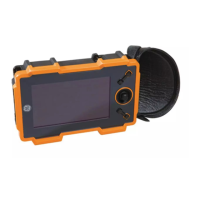
Do you have a question about the GE Ultrasonic USM Go and is the answer not in the manual?
| Brand | GE |
|---|---|
| Model | Ultrasonic USM Go |
| Category | Measuring Instruments |
| Language | English |
Explains how to connect power sources to the USM Go instrument.
Steps to turn the USM Go instrument on and off.
Overview of icons, display screen, and keypad layout.
Explains the Acquire and Setup menu structures and their functions.
Guides through initial configuration of display and operating features.
Steps for connecting and configuring a probe to the instrument.
Configuring the A-scan display parameters.
Procedures for calibrating the USM Go instrument.
Essential steps to perform before instrument calibration.
Step-by-step instructions for the AUTOCAL calibration procedure.
Setting the position and characteristics of measurement gates.
Setting the vertical and horizontal position of Gate A and Gate B.
Adjusting the horizontal start position of a gate.
Modifying the horizontal width of a gate.
Adjusting the vertical height (threshold) of a gate.
Choosing how the instrument detects signals within a gate.
Configuring alarms and indicator lights for gates.
Adjustments for angle beam probes and test piece geometry.
Configuring probe angle, X value, thickness, and diameter.
How the instrument displays various measurement readings.
Adjusting the instrument's gain level.
Using Time Corrected Gain and Distance Amplitude Correction.
Applying Distance Amplitude Correction curves.
Creating a DAC curve by recording reference points.
Applying Time Corrected Gain for consistent echo amplitudes.
Creating a TCG curve using recorded reference points.
Enhancing DAC/TCG curves with guidelines and compensation.
Comparing flaw reflecting power to standard reflectors.
Setting up probe characteristics and reference standard for DGS.
Capturing a reference echo to define the DGS curve.
Using a reference echo to evaluate subsequent echo amplitudes.
Analyzing welds and providing D1.1 or D1.5 ratings.
Applying JIS Distance Amplitude Correction curves.
Overview of functions for managing data files and reports.
Storing, recalling, and managing instrument configuration data.
Setting a name for the data recorder file.
Specifying parameters like TOP, BOTTOM, and ADV DIRECTION.
Activating a new data recorder file with specified settings.